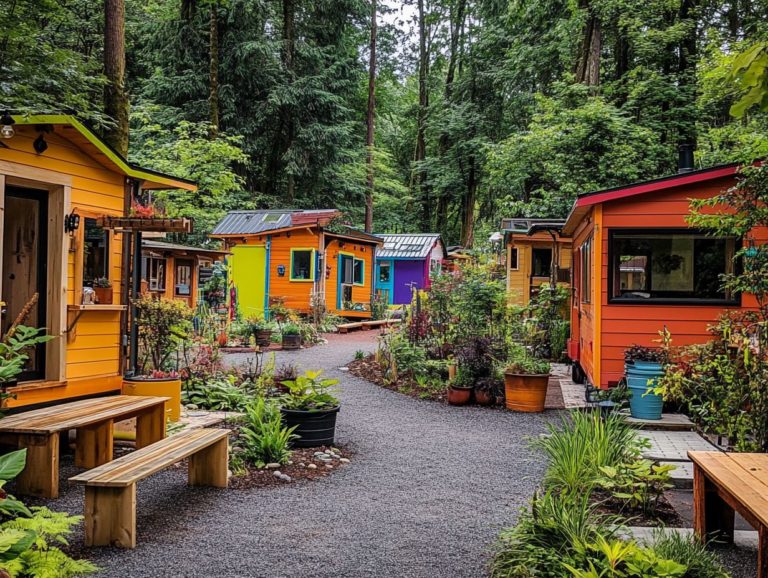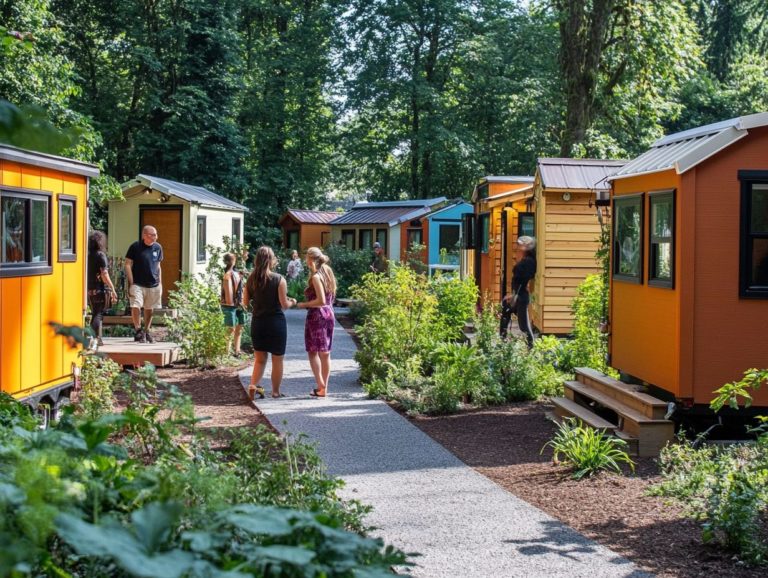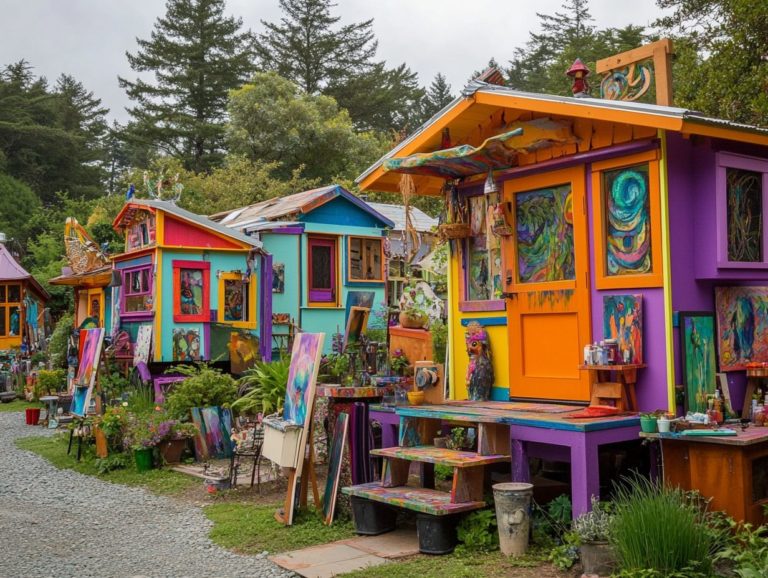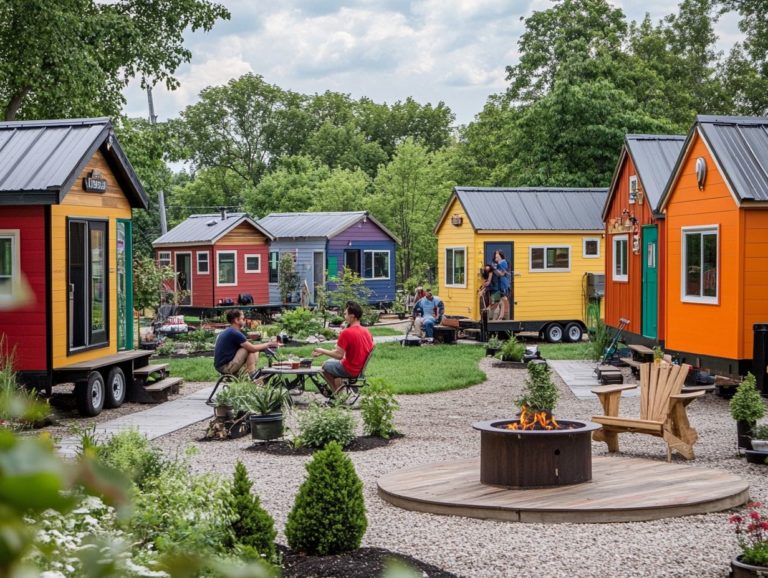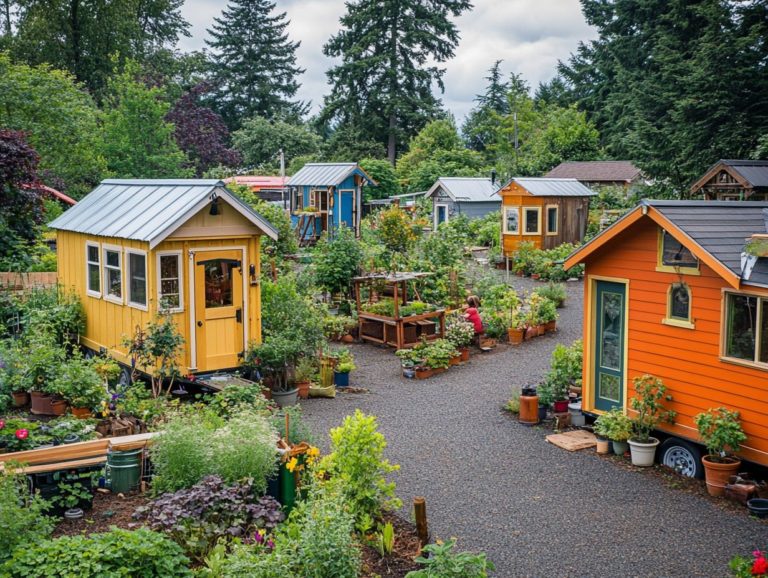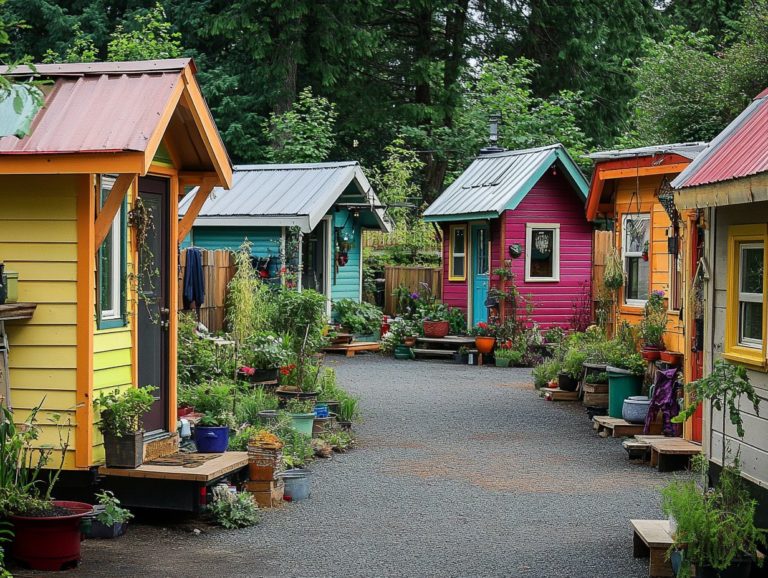The Best Tiny House Communities for Retirees
As you approach retirement, you may find yourself considering creative lifestyles that emphasize simplicity, community, and sustainability. Tiny house communities present an appealing option, combining cozy living spaces with a supportive network of fellow retirees.
This article explores the many benefits of living in these unique environments, from enriching social connections to significant environmental advantages. You ll be guided through selecting the right community, understanding associated costs, and navigating any potential challenges along the way.
Discover if a cozy tiny house community could become your dream retirement home!
Contents [hide]
- Key Takeaways:
- Why Choose a Tiny House Community for Your Retirement?
- Top Tiny House Communities for Retirees in the United States
- 3. How to Choose the Right Tiny House Community for Your Retirement
- 4. What to Consider Before Moving to a Tiny House Community as a Retiree
- 5. The Cost of Living in a Tiny House Community for Retirees
- 6. The Social Aspect of Living in a Tiny House Community as a Retiree
- 7. The Environmental Benefits of Living in a Tiny House Community as a Retiree
- 8. The Challenges of Living in a Tiny House Community as a Retiree
- 9. How to Downsize and Simplify Your Life for Retirement in a Tiny House Community
- 10. The Legal Considerations of Living in a Tiny House Community as a Retiree
- 11. The Importance of Community Guidelines and Rules in a Tiny House Community for Retirees
- 12. The Amenities and Services Offered in Tiny House Communities for Retirees
- 13. The Impact of Tiny House Communities on Local Communities and Economies
- 14. The Future of Tiny House Communities for Retirees
- 15. Is Living in a Tiny House Community the Right Choice for Your Retirement?
- Frequently Asked Questions
- What are the benefits of living in a tiny house community for retirees?
- What are some popular tiny house communities for retirees?
- Are there any age restrictions for living in a tiny house community for retirees?
- What amenities are typically offered in tiny house communities for retirees?
- Can I customize my tiny house in a retirement community?
- How do I find the best tiny house community for retirees?
Key Takeaways:
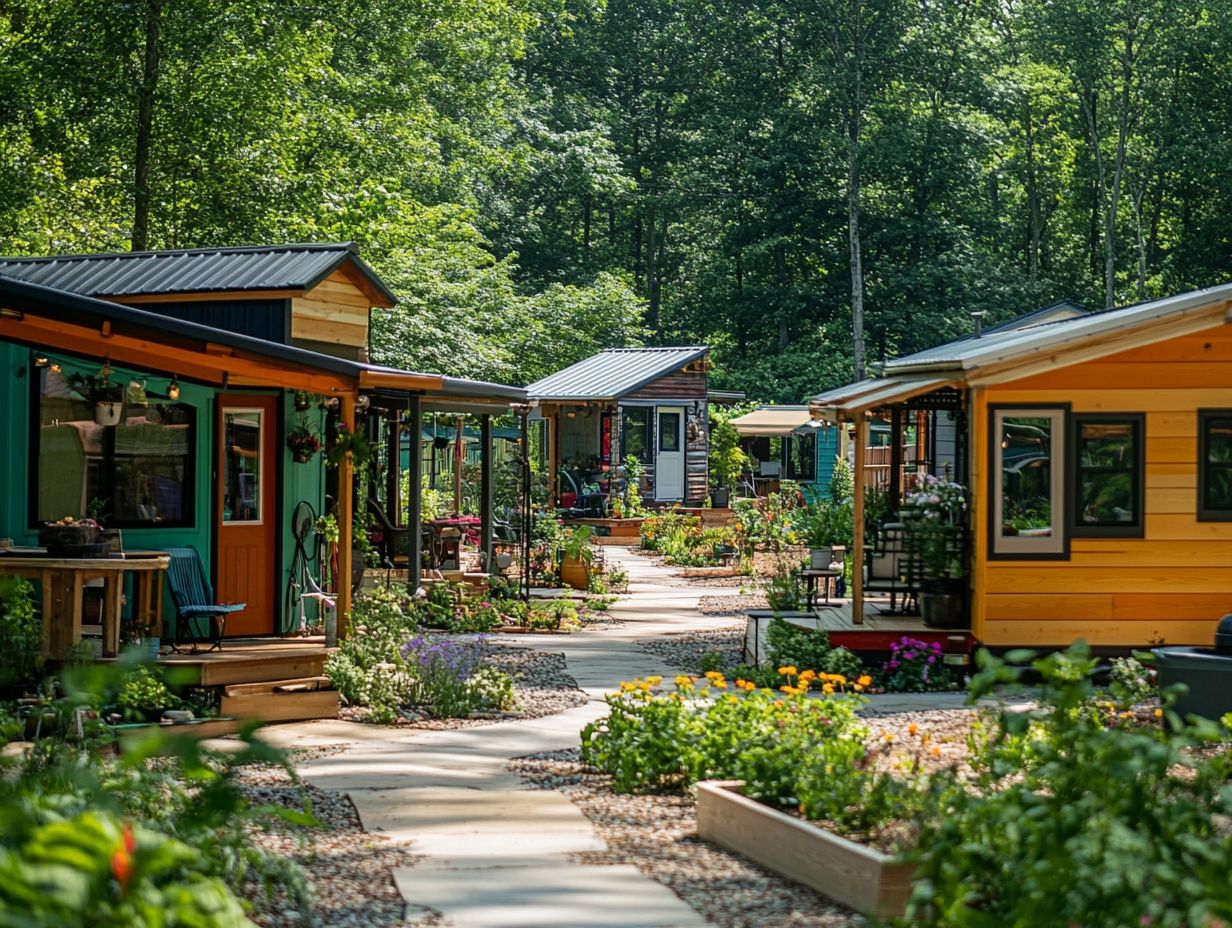
- 1. Tiny house communities offer a simpler, more affordable, and environmentally-friendly living option for retirees.
- 2. Some of the top tiny house communities for retirees in the US include The Villages in Florida, Babcock Ranch in Florida, and Boulder Creek in Colorado.
- 3. When choosing a tiny house community for retirement, consider location, community guidelines, amenities, and legal considerations.
Why Choose a Tiny House Community for Your Retirement?
Living in a tiny house community offers many advantages, especially for retirees. You ll find affordable homeownership options, a vibrant community spirit, and access to shared amenities that can elevate your quality of life while embracing a minimalist lifestyle.
This lifestyle also encourages outdoor adventures and interactions with nature, essential elements for maintaining health and well-being during retirement. By choosing tiny living, you can significantly reduce your monthly expenses, giving you the budget flexibility to explore hobbies or travel. For more insights, check out the future of tiny house communities.
The close-knit communal atmosphere fosters meaningful friendships and support networks, enriching your social life and warding off isolation. Shared amenities, such as community gardens and dog parks, provide inviting spaces for relaxation and connection, while nature trails inspire you to adopt a more physically active lifestyle.
These connections enhance your surroundings and cultivate a sense of belonging, ensuring that you remain engaged and fulfilled as you embrace this exciting new chapter of life.
Top Tiny House Communities for Retirees in the United States
Across the United States, you ll find several charming tiny house communities designed specifically for retirees, each brimming with unique features and stunning scenery that elevate the tiny living experience. From Cedar Springs Tiny Village in Ohio to eco-villages nestled in North Carolina, these communities offer an array of amenities that cater to a fulfilling retirement lifestyle.
Imagine yourself at Escape Tampa Bay in Florida, enjoying the serene environment while soaking in picturesque views of nearby lakes and lush greenery. You might also find the top tiny house communities in Florida particularly appealing, with its shared gardens that foster community bonding and promote sustainable living.
If you re a pet lover, places like Cedar Springs Tiny Village in New Mexico welcome your furry companions, ensuring they feel right at home. With strategic locations near vibrant towns, these communities are perfect for an enriching retirement experience.
Start your tiny living journey today and enjoy a fulfilling retirement!
3. How to Choose the Right Tiny House Community for Your Retirement
Choosing the right tiny house community for your retirement requires careful thought about essential factors such as location, affordability, and community features that resonate with your lifestyle. Assessing amenities, proximity to nature trails, and green spaces can help you find a community that enhances your outdoor experiences. The availability of shared outdoor spaces is also crucial for improving your quality of life.
As you explore potential communities, consider the culture and values of the residents. A supportive and engaging environment can greatly improve your retirement. Access to healthcare facilities, recreational opportunities, and vibrant social events contribute to a fulfilling life in unique tiny house communities around the world.
Be sure to evaluate the financial aspects such as HOA fees (Homeowners Association fees), property taxes, and the potential for affordable homeownership. This will help you ensure that the community is sustainable in the long run. Ultimately, understanding your personal priorities will guide you toward the features that support a joyful and active retirement.
4. What to Consider Before Moving to a Tiny House Community as a Retiree
Before making the leap to a tiny house community, consider essential factors that can significantly influence your living experience. Think about the community spirit, pet-friendly policies, outdoor adventures available, and the sustainability practices in place. Understanding the community’s shared amenities, like a dog park, can enhance your daily life.
Reflect on how lifestyle changes like adopting healthier habits and engaging with neighbors can foster a sense of belonging. Understanding the community demographics is also vital; knowing the mix of age groups can help you forge connections with like-minded individuals.
Outdoor spaces like community gardens provide perfect venues for socializing while cultivating your appreciation for nature. Dog parks offer wonderful gathering spots, encouraging leisurely strolls and light-hearted conversations among pet owners.
Such environments facilitate friendships and promote overall well-being, making it easier for you to thrive in your new surroundings.
5. The Cost of Living in a Tiny House Community for Retirees
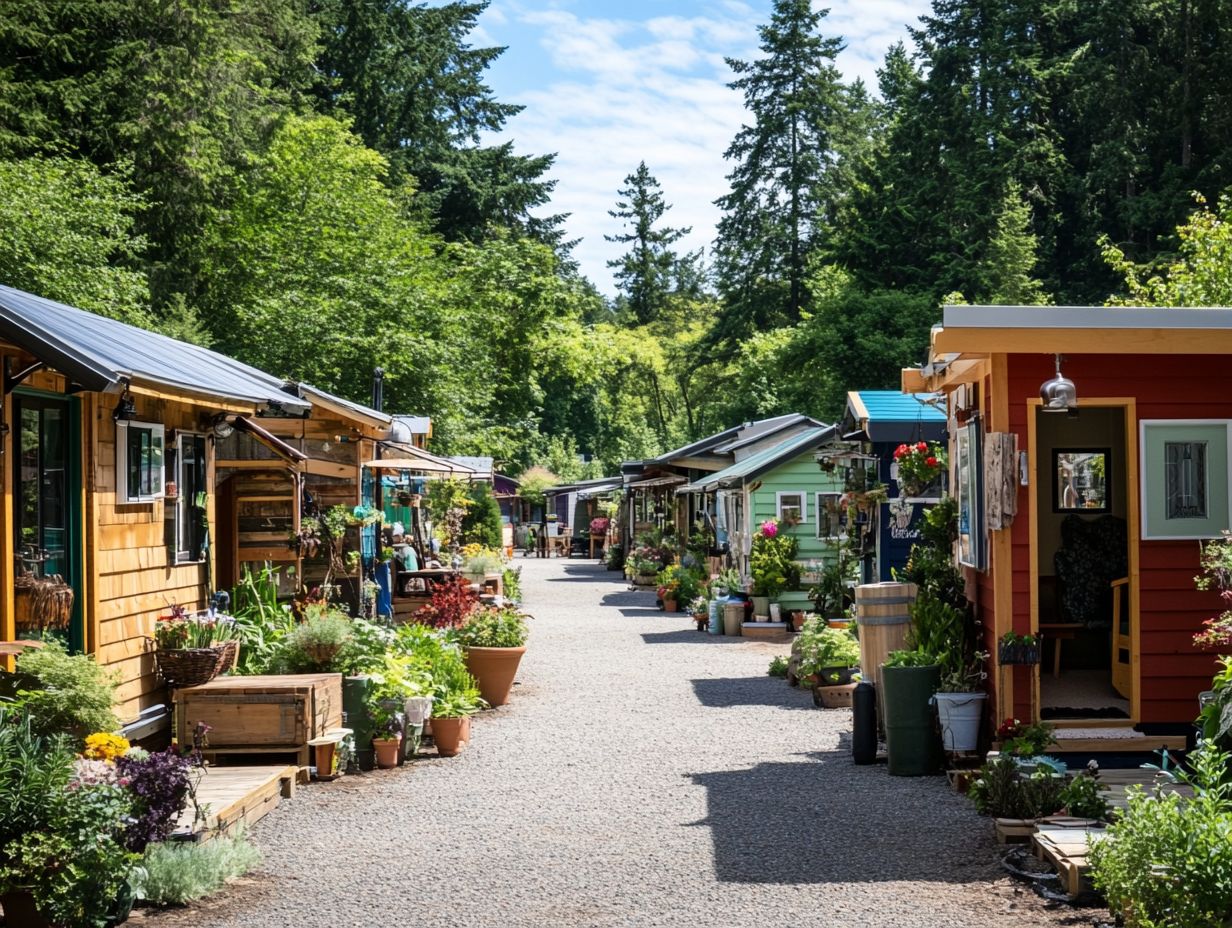
The cost of living in a tiny house community for retirees is often significantly lower than traditional homeownership. This makes it an appealing choice for those seeking affordable living without sacrificing an enriching lifestyle. With shared amenities and eco-village features, you can enjoy a financially sustainable environment that enhances your everyday experience.
By downsizing, you might drastically reduce your mortgage or rental costs, freeing up funds for essential expenses or leisure activities that matter to you. Plus, tiny homes designed for energy efficiency can lead to ongoing savings through lower utility bills.
Community resources are invaluable for enhancing your financial well-being. Shared gardens, tool libraries, and communal spaces promote cost-effective living while creating opportunities for connection. Bonding with neighbors can lead to resource sharing and cooperative purchasing, effectively lowering overall expenses while cultivating a supportive social network.
6. The Social Aspect of Living in a Tiny House Community as a Retiree
The social aspect of living in a tiny house community can elevate your retirement experience, building a robust community spirit and inspiring outdoor adventures among residents.
With shared amenities like community gardens and recreational areas, you can easily make friends and enjoy a vibrant social life.
In these close-knit settings, planned activities such as potluck dinners, game nights, and group outings create opportunities to connect on a deeper level.
The design of communal spaces not only encourages spontaneous gatherings but also fosters a warm environment where stories and experiences can be freely shared.
This level of community engagement is essential for enriching mental well-being and enhancing satisfaction during retirement.
By participating in events together, you ll discover a sense of belonging that lessens feelings of isolation and improves your overall quality of life.
7. The Environmental Benefits of Living in a Tiny House Community as a Retiree
Living in a tiny house community allows you to embrace the principles of sustainable living, giving you a chance to minimize your ecological footprint the impact our lives have on the environment while enjoying eco-village life.
With nature trails and green spaces woven into these communities, you can enjoy an environmentally friendly lifestyle that aligns with your values.
By prioritizing resource conservation and reducing energy consumption, these environments instill a sense of responsibility, sustainable living, and stewardship.
You ll actively participate in community sustainability initiatives, like communal gardens and renewable energy projects. These efforts not only enhance your quality of life but also strengthen the social bonds within your neighborhood.
Through shared resources, you can significantly reduce waste while enjoying the camaraderie that comes from working together.
This lifestyle allows you to lead by example, inspiring younger generations to adopt similar sustainable practices and contribute to nurturing a more eco-conscious society.
8. The Challenges of Living in a Tiny House Community as a Retiree
While living in a tiny house community offers numerous benefits, you may face challenges such as adapting to a minimalist lifestyle and shared amenities that require cooperation and communication with your neighbors.
Recognizing these potential hurdles is crucial for a smooth transition to tiny living.
For many, downsizing can feel overwhelming, especially when it involves parting with beloved items accumulated over the years.
To make this transition easier, consider an organized method: categorize your belongings into keep, donate, and discard piles.
Navigating community dynamics might present a learning curve, but fostering open dialogue leads to stronger relationships with fellow residents.
Adjusting to a smaller space often requires rethinking daily routines and storage solutions, so implementing clever organization hacks can maximize comfort in your cozy new environment.
9. How to Downsize and Simplify Your Life for Retirement in a Tiny House Community
Downsizing and simplifying your life for retirement in a tiny house community can be a liberating journey, promoting a minimalist lifestyle while ensuring affordable homeownership.
This transition invites you to reassess your belongings and prioritize what truly matters, leading to a more fulfilling life in your chosen tiny house community.
To embark on this decluttering journey, start by evaluating your possessions. Categorize items into keep, donate, and discard piles, making decisions based on utility and sentimental value.
Consider adopting the one-year rule if you haven t used something in the past year, it might be time to let it go.
Embracing this streamlined approach not only clears physical space but also opens up mental and emotional bandwidth, inviting more joy into your life as you engage with community features.
Ultimately, simplifying your life enhances your experience, fostering deeper connections and greater enjoyment of your surroundings.
Don’t wait to embrace a simpler lifestyle start your downsizing journey today!
10. The Legal Considerations of Living in a Tiny House Community as a Retiree
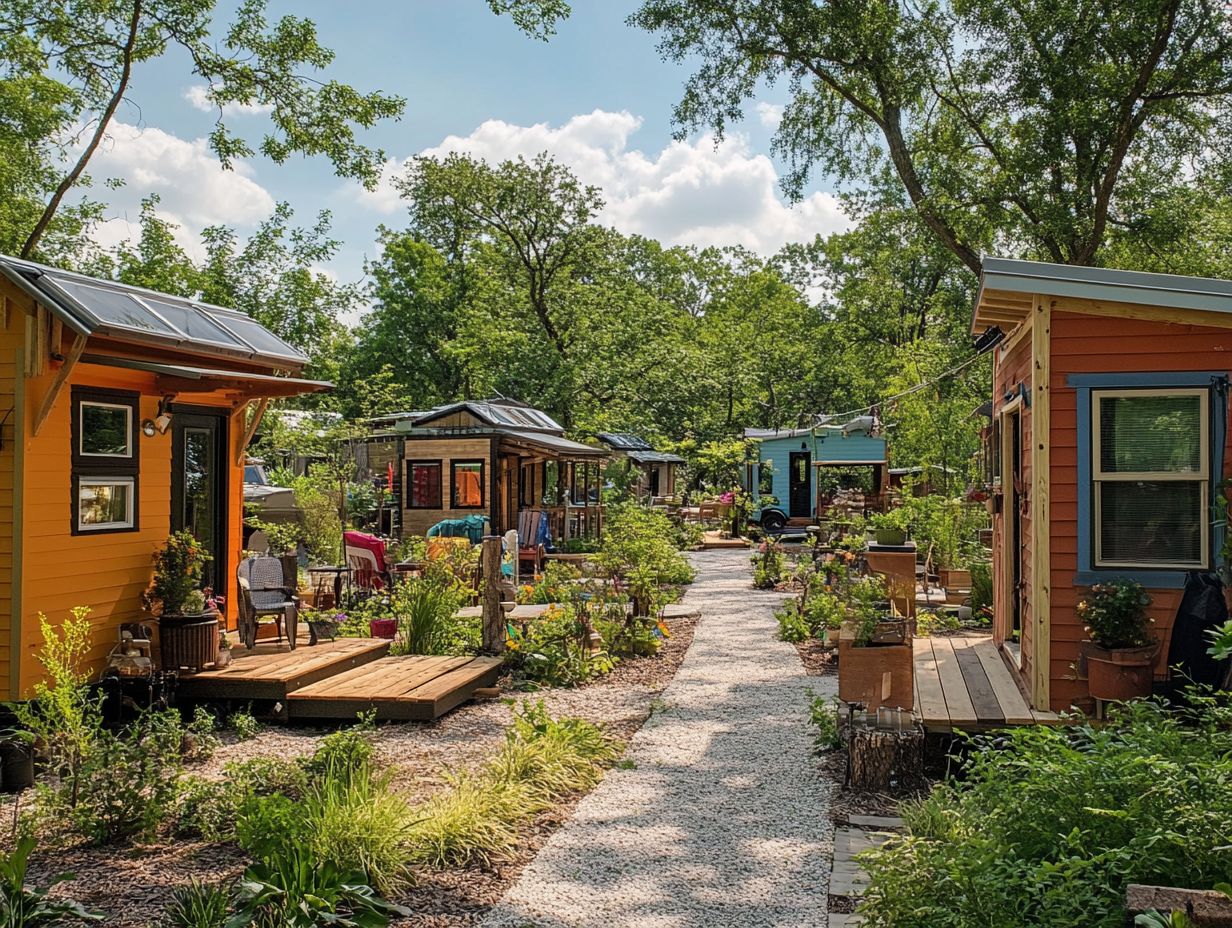
Understanding the legal aspects of living in a tiny house community is crucial for retirees. Local rules about where you can place your tiny house can vary greatly from one region to another, such as Ohio or North Carolina. Stay informed about zoning laws, building codes, and community guidelines to ensure your transition to tiny living is smooth and compliant.
Don t wait! Explore your property rights now, as some areas may have rules that limit ownership or renting of tiny homes. Familiarize yourself with the local rules about where you can place your residence and the size requirements you need to meet.
Don’t overlook lease agreements! These are essential for outlining the responsibilities and expectations between you and the landowners in a tiny house community. It’s vital to review community rules; understanding these regulations influences your daily life and helps you avoid potential conflicts with neighbors who may have different lifestyles. For more information, check out what are the best tiny house communities.
11. The Importance of Community Guidelines and Rules in a Tiny House Community for Retirees
Community guidelines and rules ensure harmony within a tiny house community, especially for retirees who value a peaceful living environment. These regulations cover shared amenities, maintenance responsibilities, and pet-friendly policies, nurturing a respectful community spirit.
These guidelines usually include quiet hours, landscaping standards, and visitor policies designed to maintain a tranquil atmosphere. Understanding and following these principles is essential; they help prevent conflicts and foster a sense of unity among residents.
By promoting effective communication and shared responsibilities, these rules create a supportive environment where everyone feels valued. Respecting each other s space and actively participating in community activities ensures an enjoyable living experience for all, enhancing the overall quality of life within the tiny house community.
12. The Amenities and Services Offered in Tiny House Communities for Retirees
Tiny house communities for retirees often come equipped with a delightful array of amenities and services that elevate your living experience. Picture this: shared spaces for community gatherings, outdoor adventures, and easy access to serene nature trails all designed to promote an active lifestyle and foster meaningful social interactions.
Many communities boast vibrant gardens where you can grow your own plants or simply enjoy nature s beauty. Recreational areas, including picnic spots and exercise zones, enhance leisure activities and help build connections with your neighbors.
Communal kitchens serve as a lively hub for shared meals, allowing you to exchange culinary skills and build friendships over delicious home-cooked dishes. These amenities enrich your daily life and significantly boost emotional well-being, weaving a sense of belonging and camaraderie into your community.
Join a tiny house community today and experience the joy of a connected lifestyle!
13. The Impact of Tiny House Communities on Local Communities and Economies
Tiny house communities offer affordable homeownership options for retirees. They also positively impact local communities and economies through sustainable living practices and features that attract a diverse array of residents.
By seamlessly integrating eco-villages into existing neighborhoods, these communities invigorate local economies and foster a spirit of collaboration. As new residents move in, they naturally increase foot traffic, benefiting local businesses as fresh customers discover neighborhood shops, restaurants, and services.
With their emphasis on sustainable living, these communities promote eco-friendly practices that effectively reduce waste and energy consumption. Take, for example, the Tiny House Village in Washington, which has thoughtfully incorporated amenities like shared gardens and communal spaces. The culture of tiny house communities further enhances this lifestyle, fostering a sense of togetherness and responsibility.
This design enhances social interaction and creates robust support networks among residents. Such synergy cultivates a vibrant atmosphere, attracting visitors and encouraging investment in the local economy. For more insight, explore the evolution of tiny house communities. Ultimately, the presence of tiny houses boosts both the environment and the local economy.
14. The Future of Tiny House Communities for Retirees
The future of tiny house communities for retirees looks bright! More individuals like you seek affordable homeownership and a sustainable lifestyle. This growing interest drives the demand for innovative housing solutions. As acceptance of tiny living expands, communities evolve to include features specifically designed to meet your changing needs.
This shift mirrors broader trends such as urbanization, where the desire to be close to amenities encourages smaller, more efficient living spaces. Sustainability movements are gaining momentum, emphasizing eco-friendly designs that minimize environmental impact ideas that resonate deeply with those seeking simpler, more intentional lifestyles.
Changing family dynamics, particularly with multigenerational living becoming more prevalent, enhance the appeal of tiny homes. Innovations like shared communal spaces, smart home technology, and modular designs pave the way for an integrated and vibrant sense of community. If you’re considering this lifestyle, exploring the best tiny house locations can help you find the perfect spot.
15. Is Living in a Tiny House Community the Right Choice for Your Retirement?
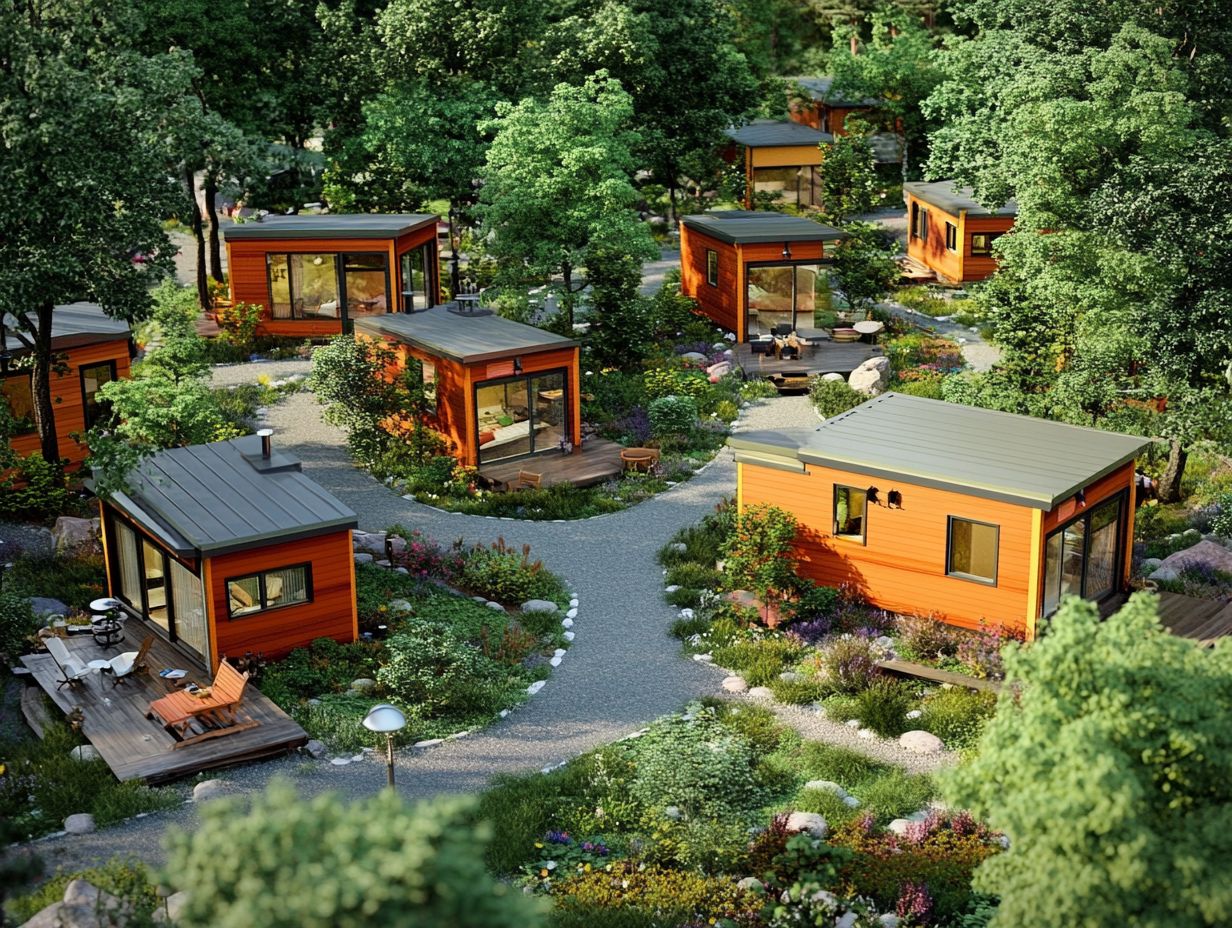
Deciding whether living in a tiny house community is the right choice for your retirement requires a thoughtful examination of your lifestyle preferences, financial situation, and desire for community spirit. Embracing tiny living can lead to a more fulfilling life, but it demands an openness to a minimalist lifestyle and shared living experiences.
You may find that this lifestyle not only alleviates financial burdens but also fosters deeper connections with neighbors, creating a fulfilling sense of belonging. Consider how this choice resonates with your personal values, particularly regarding sustainability and community engagement.
Keep in mind that smaller spaces can be challenging, potentially leading to feelings of claustrophobia or a loss of privacy. Ultimately, you are encouraged to weigh these pros and cons carefully, assessing how tiny living can either enhance or detract from your vision of a rewarding retirement in tiny house communities for young professionals that offer outdoor adventures.
Frequently Asked Questions
-
What are the benefits of living in a tiny house community for retirees?
Living in a tiny house community for retirees offers a more affordable and minimalistic lifestyle, with less maintenance and expenses. It also provides a sense of community and social connections with like-minded individuals.
-
What are some popular tiny house communities for retirees?
Some popular tiny house communities for retirees include The Meadows in Flat Rock, North Carolina, The Village at Flat Rock in Flat Rock, North Carolina, and The Villages at Crest Mountain in Asheville, North Carolina.
Are there any age restrictions for living in a tiny house community for retirees?
Many tiny house communities for retirees have age restrictions, usually for those 55 and older. Some communities, however, welcome individuals of all ages.
What amenities are typically offered in tiny house communities for retirees?
Amenities can vary by community. Common options include shared green spaces, community gardens, recreational facilities, and areas for social gatherings.
Can I customize my tiny house in a retirement community?
Yes, many tiny house communities allow customization to meet your needs. Always check the community guidelines and restrictions before making changes.
How do I find the best tiny house community for retirees?
Research and visit different tiny house communities to find one that suits you best. Consider consulting a real estate agent who has experience with these communities.

